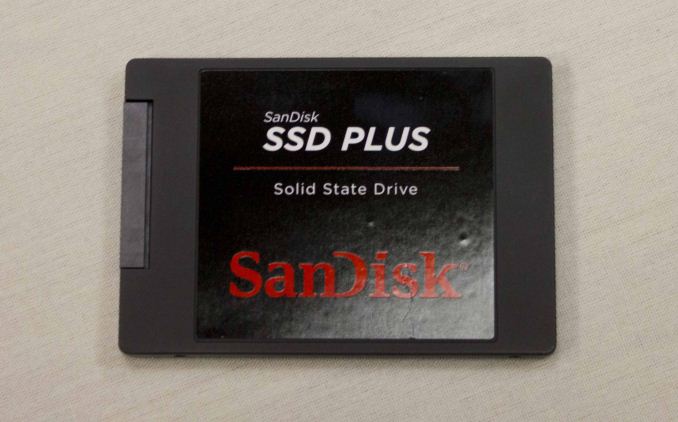SanDisk Announces Entry-Level SSD Plus & Ultra II mSATA
by Kristian Vättö on January 5, 2015 9:00 AM EST
Back in September SanDisk launched the Ultra II for the mainstream market and it's been doing pretty well in the market so far. Today here at CES SanDisk is announcing a new entry-level member to its client SSD family, which is simply called the SSD Plus. Quite surprisingly, the SSD Plus isn't based on TLC NAND, but uses SanDisk's second generation 19nm MLC NAND instead, similar to the high-end Extreme Pro. SanDisk didn't really go into detail about the hardware itself, so at this point I'm not sure where the cost savings are coming from (perhaps it's just lower binned MLC). The controller remains a secret too, although given SanDisk's history I'm pretty confident that it's a Marvell silicon with SanDisk's in-house firmware.
Availability is slated for this quarter (Q1'15) and the SSD Plus will only be available in capacities of 120GB and 240GB due to the entry-level focus. MSRPs are $70 and $110 respective with a warranty of three years. I'm still trying to wrap my head around the technological placement of the SSD Plus as it seems a bit weird to have MLC in the entry-level offering and then TLC in the one level up, but I should have a better understanding of the product once I have a sample on hand.
In addition to the SSD Plus, SanDisk is also announcing an mSATA version of the Ultra II. The core architecture remains unchanged as it's just a different form factor, although interestingly enough the mSATA flavor features less over-provisioning and is available in capacities of 128GB, 256GB and 512GB (whereas the 2.5" Ultra II is 120GB, 240GB, etc...). MSRPs are $74, $116 and $221 respectively and availability is Q1'15.










10 Comments
View All Comments
hojnikb - Monday, January 5, 2015 - link
>The controller remains a secret too, although given SanDisk's history I'm pretty confident that it's a Marvell silicon with SanDisk's in-house firmware.I dont think so. Previous gen used something from jmicron (judging from poor performance) or made inhouse. Same controller was also in their cruzer extreme flash drives.
So i dont think they gonna go marvell route this time. Not for their budget line.
TonyCL6 - Monday, January 5, 2015 - link
I wonder which model of Sandisk ever use JMicron controller in past 3 years? It is true that JMicron is notorious in SSD controller market, but that is the price a pioneer has to pay. However, as time goes by, JMicron's controller is competing with mainstream controller now. You may refer to the reference design article published by Kristian back in May 2014.Samus - Tuesday, January 6, 2015 - link
I can't find a single recent Sandisk SSD that doesn't use a Marvell controller. And the Cruzer Extreme is a flash drive, no surprise it uses a jmicron (which is based on marvell IP) like most USB 3.0 flash drives because the jmicron jmf661 and later the jmf667 were/are the only flash controllers on the market with embedded usb3.0 and sata bridges. Corsair, PNY, etc all use this controller in their high-end flash drives. The jmf667h or something like that is home in some SSD's but none from Sandisk.hojnikb - Tuesday, January 6, 2015 - link
this one for examplehttp://www.sandisk.com/products/ssd/sata/standard/
benchmark for sister drive http://www.notebookreview.com/assets/65778.jpg (pretty much the same drive, just a different formfactor).
And as you can see from the internals, it doesnt use any dram, has very tiny package (i dont think marvell makes anything that small) and uses QFP type package (marvell only makes high performance bga stuff).
All this points to some budget jmicron solution, rebranded as sandisk.
I could be wrong though.
ghanz - Wednesday, October 14, 2015 - link
I just bought one Sandisk Plus 240gb 2 days ago.It's the cheapest 240gb SSD on sale in Amazon.
While it's sequential Reads are 500+ mb/s & sequential writes 400+ mb/s respectively, it's 4k Read & Writes are not competitive with new drives. AS SSD total score is just 700.
I won't be opening mine to see what controller it uses, but it will be cool if Anandtech can review one.
Zachmcd09 - Thursday, June 16, 2016 - link
How did you achieve these speeds? I purchased one myself and I am only getting 240 read and 180 writesmilli - Friday, November 27, 2015 - link
The Sandisk SSD standard uses an in-house developed controller. Not JMicron as you suggest.Considering the SSD Plus has low IOPS too, it possibly might be using that in-house developed controller again or an evolution of it.
ghanz - Tuesday, March 15, 2016 - link
Okay, it seems to be using Silicon motion SM2246xt (a low cost Dram-less version of the SM2246en).The same controller is used in Sandisk Extreme 500 external USB 3.1 SSDs.
Hence the low IOPs ( Random Read: 28,000 IOPS*, Random Write: 65,000 IOPS*)
*On 120GB SSD with Toshiba 19nm MLC
http://images.anandtech.com/doci/9847/sata-control...
ajp_anton - Monday, January 5, 2015 - link
Doesn't MLC stand for Multi-Level Cell, meaning that TLC is in fact just one type of MLC?Kristian Vättö - Monday, January 5, 2015 - link
That is correct, but it has more or less become an industry standard that MLC refers to two-bit per cell NAND and TLC refers to three-bit per cell NAND. Technically it would be more appropriate to use 2-bit MLC and 3-bit MLC terms, but I don't find the current MLC and TLC terms to be that confusing.